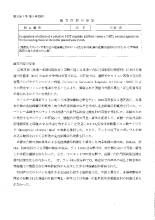The comparison of effects of a selective 5-HT reuptake inhibitor versus a 5-HT₄ receptor agonist on in vivo neurogenesis at the rectal anastomosis in rats 選択的セロトニン再取り込み阻害薬とセロトニン4受容体作動薬の直腸吻合部におけるインビボ神経再建に与える効果の比較
この論文にアクセスする
著者
書誌事項
- タイトル
-
The comparison of effects of a selective 5-HT reuptake inhibitor versus a 5-HT₄ receptor agonist on in vivo neurogenesis at the rectal anastomosis in rats
- タイトル別名
-
選択的セロトニン再取り込み阻害薬とセロトニン4受容体作動薬の直腸吻合部におけるインビボ神経再建に与える効果の比較
- 著者名
-
川原, 勲
- 学位授与大学
-
奈良県立医科大学
- 取得学位
-
博士(医学)
- 学位授与番号
-
甲第616号
- 学位授与年月日
-
2014-03-17
注記・抄録
It was recently reported that activation of enteric neural 5-HT(4) receptors (SR4) promotes reconstruction of enteric neural circuit injury in distal gut of guinea pigs and that this reconstruction involves neural stem cells. We aimed to explore a novel approach using a selective serotonin reuptake inhibitor (SSRI), which increases endogenous 5-HT, to repair enteric nerve fiber injury in the rat distal gut. Enteric nerve fiber injury was performed by rectal transection and subsequent end-to-end one-layer anastomosis. The SSRI fluvoxamine maleate (100 μmol/l) was applied locally at the anastomotic site to compare with the 5-HT(4) agonist mosapride citrate (100 μmol/l) (applied for patent) applied locally and orally. Unlike mosapride, fluvoxamine failed to promote the regeneration of the nerve fiber tract across the anastomosis. Furthermore, fluvoxamine did not generate anti-distal-less homeobox 2 (DLX2)- and anti-SR4-positive cells (neural stem cells) and/or anti-neurofilament (NF)-positive cells (neural cells) in newly formed granulation tissue at the anastomosis, whereas these cell types were observed in mosapride-treated preparations. In contrast to its effects in guinea pigs, mosapride generated 5-bromo-2'-deoxyuridine (BrdU)-positive neural cells in ganglia sites 3 mm oral and anal from the anastomosis 2 wk after nerve fiber injury. All actions of mosapride were observed after local and or oral applications. These findings indicate that local SSRI treatment does not induce in vivo nerve fiber tract growth across the anastomosis in the rat distal gut. Mosapride induces nerve fiber tract growth across the anastomosis, mediated through enteric neural stem cells possibly from neural crest-derived stem cells or mesenchymal stem cells in the bone marrow.
博士(医学)・甲616号・平成26年3月17日
発行元の規定により、本文の登録不可。本文は以下のURLを参照 "http://dx.doi.org/10.1152/ajpgi.00284.2011"
identifier:American journal of physiology. Gastrointestinal and liver physiology Vol.302 No.6 p.G588-597
identifier:01931857
identifier:http://ginmu.naramed-u.ac.jp/dspace/handle/10564/2701
identifier:American journal of physiology. Gastrointestinal and liver physiology, 302(6): G588-G597
目次
- 本文 (1コマ目)


